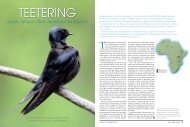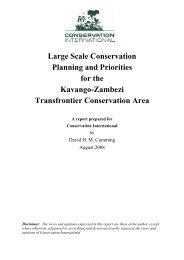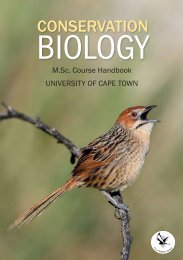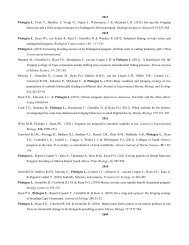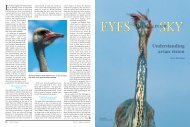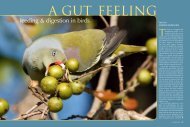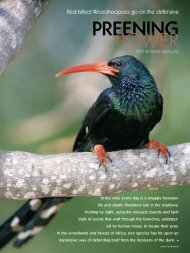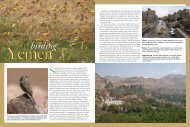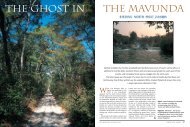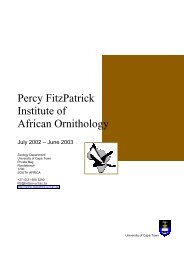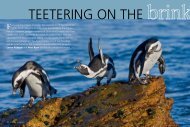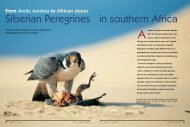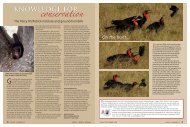Vulture research in East Africa
Vulture research in East Africa
Vulture research in East Africa
You also want an ePaper? Increase the reach of your titles
YUMPU automatically turns print PDFs into web optimized ePapers that Google loves.
Bb<br />
An adult Rüppell’s <strong>Vulture</strong> salivates<br />
<strong>in</strong> anticipation of the freshly killed<br />
carcass on which it is about to feast.<br />
down &<br />
dirty<br />
<strong>Vulture</strong> <strong>research</strong> <strong>in</strong> <strong>East</strong> <strong>Africa</strong><br />
Spend<strong>in</strong>g too much time <strong>in</strong> the presence of <strong>East</strong> <strong>Africa</strong>’s foremost<br />
raptor biologists could be bad for your health. We only came<br />
to appreciate this after spend<strong>in</strong>g six days <strong>in</strong> Kenya’s Masai Mara<br />
National Reserve with Simon Thomsett and Dr Munir Virani.<br />
Currently the doyens of <strong>East</strong> <strong>Africa</strong>n raptor (and vulture)<br />
<strong>research</strong> and conservation, these two biologists together help<br />
fill the shoes once worn by the larger-than-life Leslie Brown.<br />
text By roB simmons & mark d. anderson<br />
photographs By mark d. anderson<br />
thomsett and Virani are native<br />
to Kenya but are employed<br />
by the US conservation organisation,<br />
The Peregr<strong>in</strong>e Fund<br />
(www.peregr<strong>in</strong>efund.org). They head that<br />
body’s conservation programme <strong>in</strong><br />
Kenya, Ethiopia and Tanzania, focus<strong>in</strong>g<br />
on the present and press<strong>in</strong>g conservation<br />
concerns of the region. With<br />
83 species of diurnal raptors and 21 species<br />
of owls, and <strong>in</strong> an area with one of<br />
the fastest grow<strong>in</strong>g human populations<br />
<strong>in</strong> the world, these two conservationists<br />
have all k<strong>in</strong>ds of challenges to face.<br />
They complement each other’s skills<br />
extremely well. Virani is the organised,<br />
compact, cerebral, sporty and<br />
level-headed scientist. His dedication<br />
to Kenyan conservation is measured<br />
by the fact that, just as his Kenyan<br />
cricket<strong>in</strong>g career was about to take<br />
off, he decided that university studies<br />
were more important, and raptors took<br />
over his life. Thomsett, by contrast, is<br />
a hot-headed, op<strong>in</strong>ionated, compassionate,<br />
go-gett<strong>in</strong>g pilot and conservationist.<br />
His life has been <strong>in</strong> danger<br />
on several occasions as those opposed<br />
to his conservation ardour have taken<br />
exception to his straightforward methods<br />
by send<strong>in</strong>g <strong>in</strong> thugs to teach him<br />
a lesson. Suggest<strong>in</strong>g that he moves<br />
somewhere safer just <strong>in</strong>creases his passion<br />
to right the conservation problems<br />
around him.<br />
These two uncompromis<strong>in</strong>g biologists<br />
are responsible for highlight<strong>in</strong>g the<br />
plight of the threatened Sokoke Scops-<br />
Owl, for attempt<strong>in</strong>g to re-<strong>in</strong>troduce the<br />
Bearded <strong>Vulture</strong> <strong>in</strong>to Kenya, for reveal<strong>in</strong>g<br />
the devastat<strong>in</strong>g effects of Queleatoxspray<strong>in</strong>g<br />
on local raptor populations, for<br />
uncover<strong>in</strong>g the reasons beh<strong>in</strong>d the rise<br />
and fall <strong>in</strong> populations of Leslie Brown’s<br />
<strong>Africa</strong>n Fish-Eagles on Lake Naivasha,<br />
and for pioneer<strong>in</strong>g <strong>research</strong> on the local<br />
Augur Buzzard populations. Further<br />
afield, Virani has also played a significant<br />
role <strong>in</strong> the discovery that Diclofenac<br />
poison<strong>in</strong>g was beh<strong>in</strong>d the demise of the<br />
Oriental White-backed <strong>Vulture</strong> populations<br />
of India and Pakistan, and he<br />
cont<strong>in</strong>ues to monitor vulture breed<strong>in</strong>g<br />
colonies <strong>in</strong> India.<br />
<br />
52 booted eagle africa – birds & bird<strong>in</strong>g<br />
june/july 2007 vultures <strong>in</strong> east africa 53
Above Lappet-faced <strong>Vulture</strong>s<br />
look down from their nest on<br />
the Masai Mara.<br />
Below Simon Thomsett (left)<br />
prepar<strong>in</strong>g satellite transmitters<br />
and patagial tags, watched<br />
by Rob Simmons (centre) and<br />
Munir Virani.<br />
Opposite The Lappet-faced<br />
<strong>Vulture</strong> is considerably larger<br />
than its Rüppell’s and Whitebacked<br />
cous<strong>in</strong>s, which<br />
it dom<strong>in</strong>ates at a carcass.<br />
Back <strong>in</strong> <strong>Africa</strong>, if you want to learn anyth<strong>in</strong>g<br />
about the raptors <strong>in</strong> remote parts<br />
of Ethiopia, then the odds are good that<br />
Thomsett has been there. Several years ago,<br />
he taught himself to fly and then built his<br />
own light aircraft, thus allow<strong>in</strong>g him to regularly<br />
visit the remote regions of <strong>East</strong> <strong>Africa</strong>.<br />
Fly<strong>in</strong>g over the Rift Valley escarpment <strong>in</strong><br />
pursuit of vultures, Thomsett all but killed<br />
himself when his aircraft came down on one<br />
such trip. He escaped with a damaged shoulder<br />
and a creaky back, walk<strong>in</strong>g out of a plane<br />
that was written off and now lies twisted and<br />
mangled <strong>in</strong> a garage on his Athi River ranch,<br />
not far from Nairobi.<br />
On the occasion we met up with them, they<br />
were prepar<strong>in</strong>g for a trip to Kenya’s stunn<strong>in</strong>g<br />
Masai Mara National Reserve. This was not a<br />
holiday out<strong>in</strong>g for them, but a serious attempt<br />
to capture Rüppell’s <strong>Vulture</strong>s Gyps rueppellii for<br />
satellite tagg<strong>in</strong>g. The Masai Mara is a World<br />
Heritage Site, but it is faced with a variety<br />
of press<strong>in</strong>g concerns. Many adjacent wildlife<br />
areas that previously acted as buffers have been<br />
converted <strong>in</strong>to pastoral graz<strong>in</strong>g lands or wheatfields.<br />
The raptor community has changed<br />
and decreased <strong>in</strong> diversity, and Thomsett and<br />
Virani’s present study is aimed at determ<strong>in</strong><strong>in</strong>g<br />
the effects of this with<strong>in</strong> the reserve.<br />
The aims of the trip were to count and re-visit<br />
old nest sites. The w<strong>in</strong>g-tagg<strong>in</strong>g of the vultures<br />
would allow the <strong>research</strong>ers to assess how<br />
these birds are respond<strong>in</strong>g to change. In particular,<br />
they wanted to determ<strong>in</strong>e how Rüppell’s<br />
<strong>Vulture</strong>s time their breed<strong>in</strong>g if they are tied to<br />
cliff-nest<strong>in</strong>g, while their ungulate prey (ma<strong>in</strong>ly<br />
blue wildebeest) are constantly migrat<strong>in</strong>g away<br />
from them. Notwithstand<strong>in</strong>g the fact that the<br />
vultures’ cliff sites are already some way from<br />
their prey on the grassy pla<strong>in</strong>s, <strong>in</strong> the more than<br />
six months that it takes for a Rüppell’s <strong>Vulture</strong><br />
to rear its young from egg to first flight, the<br />
wildebeest have often moved a good distance<br />
away. By mark<strong>in</strong>g the birds with tags that use<br />
satellite technology to record hourly movements,<br />
Thomsett and Virani hope to determ<strong>in</strong>e<br />
the daily travels of the vultures to and from<br />
their nests. By do<strong>in</strong>g so they also hope to f<strong>in</strong>d<br />
new Rüppell’s colonies to add to the ones they<br />
already know of <strong>in</strong> Kenya and Tanzania.<br />
when we were <strong>in</strong>vited to jo<strong>in</strong><br />
them for a spot of <strong>research</strong>, we<br />
jumped at this, the opportunity<br />
of a lifetime. We weren’t<br />
disappo<strong>in</strong>ted, either. For many reasons, the<br />
journey proved almost as memorable as the<br />
dest<strong>in</strong>ation. The surfaces euphemistically called<br />
roads <strong>in</strong> Kenya were best avoided (it was far<br />
safer to travel on the dusty shoulders than<br />
to crash <strong>in</strong>to pothole after pothole), while<br />
the traffic ‘rules’ that Kenyan drivers employ<br />
were more than a little stressful to foreigners<br />
like ourselves. The m<strong>in</strong>or fact that Thomsett’s<br />
four-wheel-drive vehicle lacked brakes for most<br />
of the journey down the escarpment and the<br />
entire journey back meant that we drew straws<br />
to decide who got the ‘suicide seat’ up front<br />
next to him. Virani simply refused to budge<br />
from the back.<br />
Eight hours of this tortuous outward journey<br />
ended with an after-dark attempt at f<strong>in</strong>d<strong>in</strong>g<br />
our tented accommodation at the recently<br />
opened Olare Safari Camp, perched near a<br />
dry river-bed, one degree south of the equator<br />
<strong>in</strong> the Masai Mara Reserve. Suddenly the trip<br />
improved markedly: we were treated to luxury<br />
– good food and hot showers – for the next<br />
We were treated to luxury for the next few days. This<br />
was a welcome end to long, hot days spent on the open<br />
grassy pla<strong>in</strong>s, handl<strong>in</strong>g smelly vultures and dragg<strong>in</strong>g<br />
bloody carcasses about for their enjoyment<br />
few days. This was a welcome end to long, hot<br />
days spent on the open grassy pla<strong>in</strong>s, handl<strong>in</strong>g<br />
smelly vultures and dragg<strong>in</strong>g bloody carcasses<br />
about for their enjoyment.<br />
Initially, it was difficult to comprehend that<br />
all those childhood films depict<strong>in</strong>g the mass<br />
migrations of wildebeest on the Serengeti were<br />
unfold<strong>in</strong>g <strong>in</strong> front of us. Like all tourists, we<br />
spent the first few days beh<strong>in</strong>d our cameras,<br />
photograph<strong>in</strong>g wildebeest, elephant and buffalo<br />
from every angle, while Thomsett and<br />
Virani patiently waited for us to re-focus on<br />
their project. Of course, with the hundreds of<br />
thousands of wildebeest come the terrestrial<br />
predators, so we photographed them too... We<br />
saw lion, cheetah and spotted hyaena on a<br />
daily basis and, while the hordes of visitors<br />
were watch<strong>in</strong>g them, we were scann<strong>in</strong>g the<br />
skies for vultures – hundreds and hundreds<br />
Mombasa<br />
Ocean<br />
TANzANIA<br />
Indian<br />
54 vultures <strong>in</strong> east africa africa – birds & bird<strong>in</strong>g<br />
june/july 2007 vultures <strong>in</strong> east africa 55<br />
UgANDA<br />
ETHIOPIA<br />
MAsAi<br />
MArA NP<br />
KENyA<br />
Nairobi<br />
SOMALIA
Below Simon Thomsett<br />
uses an <strong>in</strong>genious method to<br />
capture vultures. By plac<strong>in</strong>g<br />
nooses at strategic positions<br />
on the blue wildebeest<br />
carcass, he is able to catch<br />
vultures without caus<strong>in</strong>g<br />
them undue stress or any<br />
<strong>in</strong>jury as they stick their feet<br />
and heads <strong>in</strong>to the rema<strong>in</strong>s.<br />
Bottom Future observations<br />
of this tagged <strong>Africa</strong>n<br />
White-backed <strong>Vulture</strong> will<br />
provide valuable <strong>in</strong>formation<br />
about the movements of<br />
vultures <strong>in</strong> the Serengeti ecosystem,<br />
especially relative to<br />
the ever-chang<strong>in</strong>g location of<br />
the herds of large ungulates.<br />
of them. Most were the ubiquitous Whitebacked<br />
<strong>Vulture</strong>s G. africanus, but among them<br />
– and the reason for our visit – were the large<br />
and majestic Rüppell’s <strong>Vulture</strong>s.<br />
The <strong>East</strong> <strong>Africa</strong>n equivalent of southern<br />
<strong>Africa</strong>’s Cape <strong>Vulture</strong> G. coprotheres, Rüppell’s<br />
also nest only on relatively <strong>in</strong>accessible cliffs.<br />
They differ from the Cape <strong>Vulture</strong> <strong>in</strong> that<br />
they rely on migrant herds of ungulates that<br />
complete a slow, circular migration over <strong>East</strong><br />
<strong>Africa</strong>’s grassy pla<strong>in</strong>s. Past <strong>research</strong> by David<br />
Houston has also shown that Rüppell’s are<br />
somewhat aseasonal breeders: many pairs simply<br />
start breed<strong>in</strong>g when they have recovered<br />
from their previous attempt, rais<strong>in</strong>g one chick<br />
at a time. S<strong>in</strong>ce the reproductive cycle is just less<br />
than one year, they gradually beg<strong>in</strong> breed<strong>in</strong>g<br />
slightly earlier each year, which <strong>in</strong> effect moves<br />
the cycle backwards around the annual clock.<br />
Cape <strong>Vulture</strong>s, by contrast, have a def<strong>in</strong>ite<br />
breed<strong>in</strong>g season, beg<strong>in</strong>n<strong>in</strong>g with egg-lay<strong>in</strong>g <strong>in</strong><br />
May/June, see<strong>in</strong>g the first flighted chick some<br />
200 days later, and generally f<strong>in</strong>ish<strong>in</strong>g before<br />
the end of the year. The breed<strong>in</strong>g cycle of the<br />
few Rüppell’s <strong>Vulture</strong>s present at southern<br />
<strong>Africa</strong>’s largest Cape <strong>Vulture</strong> colonies would<br />
therefore be <strong>in</strong>terest<strong>in</strong>g to monitor.<br />
the rout<strong>in</strong>e for catch<strong>in</strong>g the Masai<br />
Mara’s vultures was straightforward.<br />
In the early morn<strong>in</strong>gs we looked for<br />
overnight kills or scanned the sky for<br />
vultures, determ<strong>in</strong><strong>in</strong>g where they were head<strong>in</strong>g<br />
and spirall<strong>in</strong>g down. The sheer number of<br />
carcasses taken down dur<strong>in</strong>g the night meant<br />
the wait was never long, but the next trick<br />
was to avoid the areas where the tourists were<br />
head<strong>in</strong>g. Not so easy! The Mara lacks the feel<br />
of untouched wilderness found <strong>in</strong> the vulture<br />
lands of Namibia and the Northern Cape,<br />
and with planes regularly fly<strong>in</strong>g <strong>in</strong> hundreds<br />
of tourists, and up to 30 game-drive vehicles<br />
view<strong>in</strong>g sleep<strong>in</strong>g lions, our task of f<strong>in</strong>d<strong>in</strong>g un-<br />
peopled carcasses sometimes proved difficult.<br />
Eventually this too was accomplished and<br />
the project could beg<strong>in</strong>. given the somewhat<br />
skittish nature of vultures at carcasses<br />
<strong>in</strong> southern <strong>Africa</strong>, we were <strong>in</strong>itially amazed<br />
at those on the Masai Mara, as the birds came<br />
directly onto carcasses and rarely took off as<br />
our vehicle approached. Both White-backed<br />
and Rüppell’s vultures simply bounded off and<br />
waited patiently some 20 to 50 metres away.<br />
Thomsett used the vehicle to conceal his activities,<br />
while we watched for the big predators<br />
and tourists. Us<strong>in</strong>g a knife to obta<strong>in</strong> a good<br />
purchase <strong>in</strong> the often freshly killed carcass,<br />
Thomsett expertly tied a set of nylon-covered<br />
wire nooses around the deceased animal, from<br />
horns to rear, position<strong>in</strong>g them where the vultures<br />
would have to step on or through them to<br />
reach the feed<strong>in</strong>g area.<br />
True to his frontiersman image, Thomsett<br />
often tucked <strong>in</strong>to coffee and sandwiches after<br />
hav<strong>in</strong>g spent much of the morn<strong>in</strong>g with his<br />
hands buried deep <strong>in</strong>side the freshly killed carcasses.<br />
Our job was then simply to drive some<br />
100 metres away, and wait for the action. We<br />
were chiefly <strong>in</strong>terested <strong>in</strong> Rüppell’s <strong>Vulture</strong>s,<br />
but as the vulture community is dom<strong>in</strong>ated by<br />
White-backs, we often caught the latter species<br />
first. It was rare that two birds were captured<br />
together, as <strong>in</strong>dividuals that were caught often<br />
panicked on realis<strong>in</strong>g their predicament. Their<br />
flapp<strong>in</strong>g caused concern among the other feed<strong>in</strong>g<br />
birds and we had to rush <strong>in</strong> to release and<br />
subdue the trapped White-backs, quickly popp<strong>in</strong>g<br />
them <strong>in</strong> a large sack to keep them quiet,<br />
and hop<strong>in</strong>g that the target birds would return.<br />
Aga<strong>in</strong>, <strong>in</strong> southern <strong>Africa</strong>, most vulture biologists<br />
would leave the carcass with little hope of<br />
see<strong>in</strong>g any vultures return to the crime scene.<br />
Not so <strong>in</strong> the Masai Mara, where the wait<strong>in</strong>g<br />
mob often bounded <strong>in</strong> aga<strong>in</strong> to fight and<br />
squabble over the carcass as soon as we were<br />
about 100 metres away.<br />
As one observer watched for other captured<br />
birds, each sacked vulture was fitted with a<br />
large, brightly coloured patagial tag, p<strong>in</strong>ned<br />
through the lead<strong>in</strong>g edge of its w<strong>in</strong>g, for<br />
future observations by rangers and guides,<br />
and by Thomsett and Virani.<br />
The real prize, the larger Rüppell’s, was harder<br />
to capture, but after a few days of trapp<strong>in</strong>g, one<br />
was caught and given the full treatment: a specially<br />
designed patagial tag with a satellite transmitter,<br />
weigh<strong>in</strong>g about 120 grams. S<strong>in</strong>ce our<br />
visit, these two dedicated raptor biologists have<br />
managed to capture several more and soon the<br />
<strong>in</strong>formation that is gleaned from their movements<br />
should tell Thomsett and Virani what<br />
they need to know about the forag<strong>in</strong>g strategies<br />
and breed<strong>in</strong>g schedules of <strong>East</strong> <strong>Africa</strong>’s Rüppell’s<br />
<strong>Vulture</strong>s. The data are likely to be extremely<br />
valuable, given that similar <strong>in</strong>formation gleaned<br />
from Namibia’s Cape <strong>Vulture</strong>s, satellite-tagged<br />
by Maria Diekmann near the Waterberg Plateau<br />
Park, has revolutionised our understand<strong>in</strong>g<br />
of the movements of these highly threatened<br />
birds. Data such as daily forag<strong>in</strong>g distance, total<br />
Given the somewhat skittish nature of vultures <strong>in</strong><br />
southern <strong>Africa</strong>, we were <strong>in</strong>itially amazed at those on the<br />
Masai Mara, as the birds came directly onto carcasses and<br />
rarely took off as our vehicle approached<br />
forag<strong>in</strong>g range, habitat used and even the carcasses<br />
they fed on three months previously,<br />
can be gleaned from such data mixed with<br />
ground-truth<strong>in</strong>g. Of course the similarities and<br />
differences between these two closely related<br />
species on either side of the equator will make<br />
a fasc<strong>in</strong>at<strong>in</strong>g contrast <strong>in</strong> lifestyles.<br />
It is a tribute to Thomsett and Virani that<br />
they have cont<strong>in</strong>ued with their <strong>research</strong> under<br />
often try<strong>in</strong>g circumstances and despite the fact<br />
that many of their <strong>in</strong>dividually marked raptors<br />
have disappeared. Indeed, often entire populations<br />
of birds they have observed for many<br />
years have vanished, as land-use practices and<br />
human pressures imp<strong>in</strong>ge on areas that were<br />
prist<strong>in</strong>e when they began their observations.<br />
Fortunately, both men are highly committed<br />
to their work and it was an immense pleasure<br />
to spend time <strong>in</strong> their company. We will long<br />
remember the detailed discussions that we had<br />
with them regard<strong>in</strong>g the f<strong>in</strong>er po<strong>in</strong>ts of their<br />
<strong>research</strong> and the future of conservation of <strong>East</strong><br />
<strong>Africa</strong>n birds of prey.<br />
<br />
The feed<strong>in</strong>g mêlée of<br />
<strong>in</strong>teract<strong>in</strong>g vultures at a<br />
carcass provides one of the<br />
most enterta<strong>in</strong><strong>in</strong>g dramas<br />
to watch on the <strong>Africa</strong>n<br />
savannas.<br />
56 vultures <strong>in</strong> east africa africa – birds & bird<strong>in</strong>g<br />
june/july 2007 vultures <strong>in</strong> east africa 57



